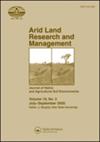Agroecological sub-zone based sustainable land use in arid Rajasthan (India)
IF 1.9
4区 农林科学
Q3 ENVIRONMENTAL SCIENCES
引用次数: 2
Abstract
Abstract The arid region of Rajasthan has been classified into unique agro-ecological sub-regions, zones, and sub-zones (indicated by their code number in this abstract) for which sustainable land use has been suggested based on the potentials and constraints. 2.1, 2.2 and 3.1 sub-zones need dune stabilization, silvopastural farming, and kharif cultivation in interdunes; khadin water harvesting system, as well as solar farming. 4.1 and 4.2 sub-zones need rainfed cropping under conserved moisture, agroforestry and limited irrigation, cultivation of low water requiring crops, such as mustard, cumin in rabi. In 4.3 sub-zone under conserved moisture and winter rainfall pulses and mustard are suggested. In 5.1 and 5.2 sub-zones kharif season crops and wheat, mustard, cumin, and condiments irrigated with brackish groundwater by adopting gypsum treatment are suggested. In the canal command area, the micro-irrigation system is doing well in the sandy plain and dune complex area, but in the Ned area irrigation needs to be restricted/avoided. In 5.3 and 5.4 sub-zones, rainfed irrigated crops and fruit cultivation is suggested. In 6.1 sub-zone dune stabilization is suggested; 6.2 and 6.3 sub-zones require erosion control and irrigation water management for the cultivation of cotton, paddy, groundnut, sugarcane, and kinnow.基于农业生态分区的印度拉贾斯坦邦土地可持续利用研究
摘要:本文将拉贾斯坦邦干旱区划分为独特的农业生态分区、区和分区,并根据其潜力和制约因素提出了土地可持续利用的建议。2.1、2.2和3.1分区需要沙丘稳定、林草耕作和垄间刈耕;哈丁集水系统,以及太阳能农业。4.1和4.2分区需要保持水分的旱作、农林业和有限灌溉、种植低需水量作物,如芥菜、小茴香。在4.3分区,在保湿和冬季降雨条件下,建议采用豆类和芥菜。在5.1和5.2分区,建议采用石膏处理方式灌溉半咸淡水,灌溉季作物和小麦、芥菜、孜然、调味品。在渠系指挥区,微灌系统在沙质平原和沙丘复杂地区表现良好,但在Ned地区需要限制/避免灌溉。在5.3和5.4分区,建议种植雨灌作物和水果。6.1建议分区沙丘稳定化;6.2和6.3分区需要水土流失控制和灌溉用水管理,以种植棉花、水稻、花生、甘蔗和金农。
本文章由计算机程序翻译,如有差异,请以英文原文为准。
求助全文
约1分钟内获得全文
求助全文
来源期刊

Arid Land Research and Management
环境科学-环境科学
CiteScore
3.80
自引率
7.10%
发文量
23
审稿时长
9 months
期刊介绍:
Arid Land Research and Management, a cooperating journal of the International Union of Soil Sciences , is a common outlet and a valuable source of information for fundamental and applied research on soils affected by aridity. This journal covers land ecology, including flora and fauna, as well as soil chemistry, biology, physics, and other edaphic aspects. The journal emphasizes recovery of degraded lands and practical, appropriate uses of soils. Reports of biotechnological applications to land use and recovery are included. Full papers and short notes, as well as review articles and book and meeting reviews are published.
 求助内容:
求助内容: 应助结果提醒方式:
应助结果提醒方式:


